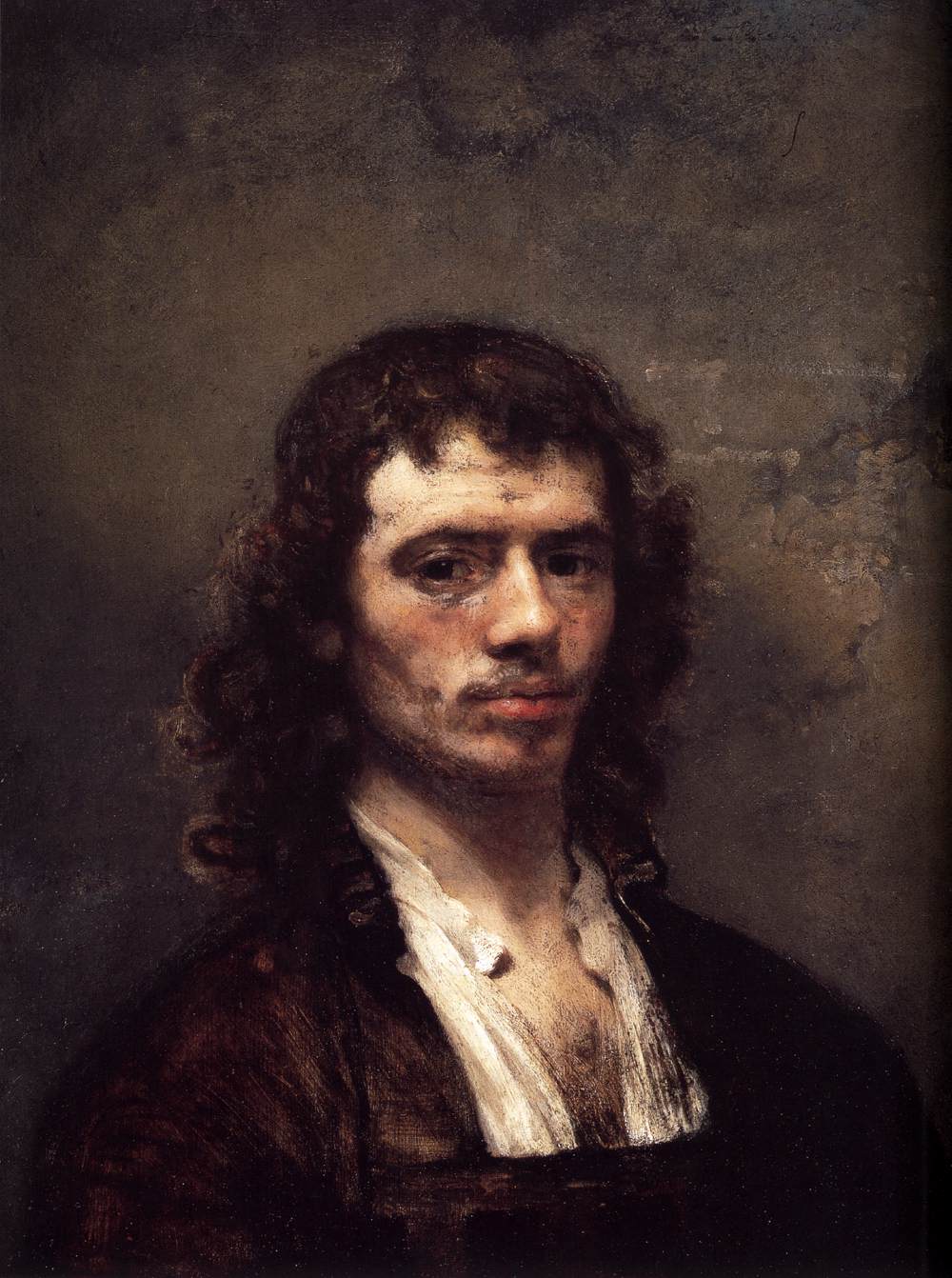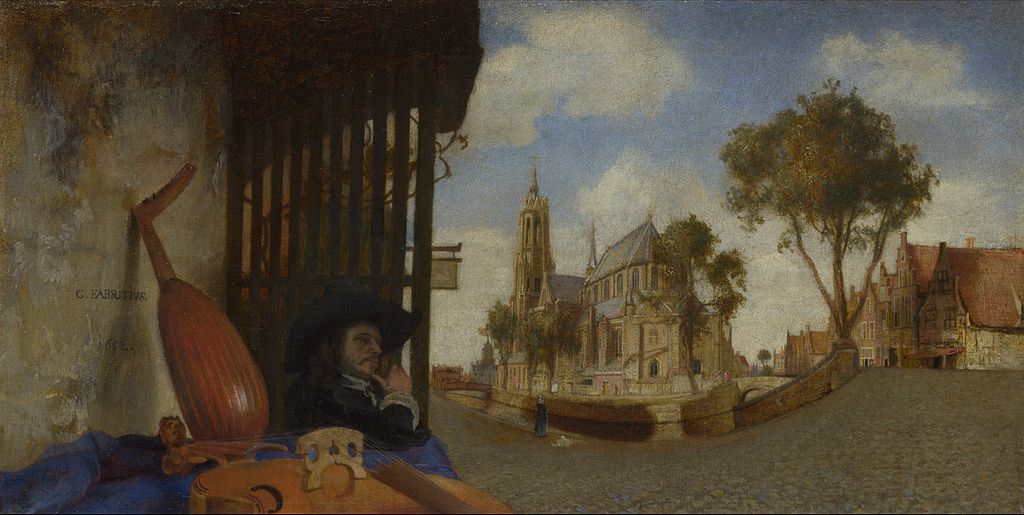
The Goldfinch: Carel Fabritius, 1654 (Mauritshuis, The Hague)
The painter Carel Fabritius was born in 1632, the son of a schoolteacher in Midden Beemster, a polder town then only recently reclaimed from peat bog and marsh land. As a boy he worked as a carpenter (Lat. fabritius), which may be the source of his self-selected art-historical name. A poem in his memory written by Arnold Bon calls him Karel Faber: Karel the Maker. It seems his father may have been his first painting instructor. As a boy he went to Amsterdam to study for two years under Rembrandt. (Carel's brother Barent, two years younger and also a painter, may well have followed him to study and work under the same master.) He was perhaps Rembrandt's most gifted pupil. The influence of master upon student is apparent in an early Fabritius self-portrait, done in his twenty-third year.

Self-Portrait: Carel Fabritius, 1645 (Museum Boijmans Van Beuningen, Rotterdam)
Fabritius' mastery of trompe l'oeil effects, made possible by deft handling of a loaded brush, set him off from other painters of his day. His figures emerge as shapes in the world, cool and luminous. They convey not solitudes burdened with Rembrandtian earthen gravity but harmonious interrelations of colour and light. Space and light become new media of experiment in Fabritius' hands.
In the early 1650s Fabritius moved to Delft, where he became a member of the local painters' guild, and exerted a strong influence upon other painters working in the city at the time, including Vermeer and de Hooch.
His innovative exploration of the manipulation of illusion through radical perspective appears in the remarkable 1652 A View of Delft, with a Musical Instrument Seller's Stall, in which the curious perspectival distortion has led art historians to speculate that the canvas might once have been attached to the back wall of a peep-box. In this painting, the writing on the wall by the shadow of the lute is the artist's signature: C. Fabritius, inscribed in the perspective of the scene.

A View of Delft, with a Musical Instrument Seller's Stall: Carel Fabritius (1622-1654), 1652 (National Gallery, London)
The exquisite delicacy of Fabritius' lighting effects can be seen most notably in his masterpiece, The Goldfinch (1654), a painting at once wonderful in its assimilation into the substantial being of the chained pet bird, and terribly sad -- who can look intently at this picture without experiencing the inner wish that the lonesome tethered creature be set free?

The Goldfinch: Carel Fabritius, 1654 (Mauritshuis, The Hague)
Fabritius was still but a young man of 32 when his art -- and life -- were cut short by catastrophe. On 12 October 1654, thirty tons of gunpowder, stored in barrels in a magazine in a former convent, were ignited when a keeper opened the store for inspection. The "Delft Thunderclap," as it was called, destroyed a quarter of the city. Fabritius' studio, and many of his paintings, were lost. (Only about a dozen have survived.) Fabritius, his student Mattias Spoors and a church deacon, Simon Decker, who were working together with him on a painting at the time, all died as a result of the blast.

Self-Portrait: Carel Fabritius, 1654 (National Gallery, London)

Self-Portrait: Carel Fabritius, 1645 (Museum Boijmans Van Beuningen, Rotterdam)
Returning to Beemster in the 1640s, the earnest learner would step out of his teacher's large shadow, establish his own studio and develop his art beyond that of the famous master, abandoning Rembrandt's characteristic dark backgrounds for backgrounds in light, textured colours.
Fabritius' mastery of trompe l'oeil effects, made possible by deft handling of a loaded brush, set him off from other painters of his day. His figures emerge as shapes in the world, cool and luminous. They convey not solitudes burdened with Rembrandtian earthen gravity but harmonious interrelations of colour and light. Space and light become new media of experiment in Fabritius' hands.
In the early 1650s Fabritius moved to Delft, where he became a member of the local painters' guild, and exerted a strong influence upon other painters working in the city at the time, including Vermeer and de Hooch.
His innovative exploration of the manipulation of illusion through radical perspective appears in the remarkable 1652 A View of Delft, with a Musical Instrument Seller's Stall, in which the curious perspectival distortion has led art historians to speculate that the canvas might once have been attached to the back wall of a peep-box. In this painting, the writing on the wall by the shadow of the lute is the artist's signature: C. Fabritius, inscribed in the perspective of the scene.

A View of Delft, with a Musical Instrument Seller's Stall: Carel Fabritius (1622-1654), 1652 (National Gallery, London)
The exquisite delicacy of Fabritius' lighting effects can be seen most notably in his masterpiece, The Goldfinch (1654), a painting at once wonderful in its assimilation into the substantial being of the chained pet bird, and terribly sad -- who can look intently at this picture without experiencing the inner wish that the lonesome tethered creature be set free?

The Goldfinch: Carel Fabritius, 1654 (Mauritshuis, The Hague)
Fabritius was still but a young man of 32 when his art -- and life -- were cut short by catastrophe. On 12 October 1654, thirty tons of gunpowder, stored in barrels in a magazine in a former convent, were ignited when a keeper opened the store for inspection. The "Delft Thunderclap," as it was called, destroyed a quarter of the city. Fabritius' studio, and many of his paintings, were lost. (Only about a dozen have survived.) Fabritius, his student Mattias Spoors and a church deacon, Simon Decker, who were working together with him on a painting at the time, all died as a result of the blast.

View of Delft after the Explosion of 1654, in which most of the city was damaged: Egbert van der Poel (1621-1664), 1654 (National Gallery, London)

Self-Portrait: Carel Fabritius, 1654 (National Gallery, London)

No comments:
Post a Comment